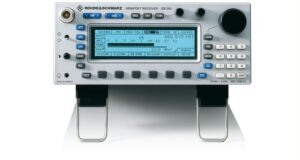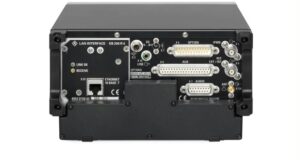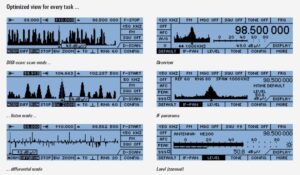The Monitoring Receiver R&S®EB200 from Rohde & Schwarz is ideally suited for military monitoring tasks and spectrum monitoring in line with ITU recommendations as well as for use in radio investigation services.
The range of applications includes:
- Signal detection
- Signal search in frequency and memory scan mode
- Spectrum occupancy measurement
- RF and IF analysis
- Coverage measurements (option)
- Field-strength measurements
R&S®EB200 is a monitoring and test receiver for all radio detection and radio monitoring tasks in line with ITU-R, and for radio investigation services. The compact and sturdy design combined with low weight makes the R&S®EB200 a versatile and universal unit for stationary and mobile use.
EB200 fulfills the following tasks:
- Monitoring of given frequencies, e.g. storage of 1 to 1000 frequencies, squelch settings, constant monitoring of one frequency or cyclical scanning of several frequencies
- Searching in a frequency range with freely selectable start and stop frequency and step widths of 1 kHz to 9.999 MHz
- Location of close-range to medium-range targets with the aid of Handheld Directional Antenna HE200
- Detection of undesired emissions including pulsed emissions
- Detection of unlicensed transmitters communicating illegally or interfering with licensed transmission.
- Protection against tapping by detecting miniature spy transmitters (bugs)
- Monitoring of one’s own radio exercises in a service band
- Monitoring of selected transmissions
- Remote-controlled operation via modem and PC in coverage measurement and monitoring systems
Features & Benefits:
- Ergonomic design for portable use
- Continuous frequency range from 10 kHz to 3 GHz
- Tracing illegal transmitters
- Localisation of destination transmitter at close and medium range using the HE200 manual directional antenna
- Digital IF-Part with 12 band widths (150 Hz to 150 kHz)
- Fast, precise, level indicator over 110 dB dynamic range
- Search loop options: Frequency search and memory search
- Frequency spectrum (Option)
- IF-Panorama-Display (Option)
- Remote control through RS232 C PPP or LAN (Ethernet 10Base-T)
Brief Description
FUNCTION
The R&S®EB200 is a superhet receiver with a third intermediate frequency of 10.7 MHz. In spite of its compact size, it was possible to implement an advanced receiver concept. The receiver input is equipped with a highpass / lowpass combination or tracking preselection, as required, to reduce the signal sum load. Intermodulation suppression equals that of many receivers used in stationary applications. The low degree of oscillator reradiation is a result of large-scale filtering. A modern synthesizer concept featuring very low phase noise permits switching times of less than 3 ms. Effective frequency and memory scanning is thus possible
DIGITAL IF SECTION
The R&S®EB200 covers the wide frequency range from 10 kHz to 3 GHz. Processing all signals available with optimum signal-to-noise ratio requires a large number of IF bandwidths. This problem cannot be solved by means of analog filters as space is limited. The solution is a digital IF section in which a wide variety of different filters can be implemented in a relatively small space with the aid of DSP. The EB200 has 12 IF bandwidths between 150 Hz and 150 kHz. The following digital demodulators are available: AM, FM, LSB, USB and CW. If the receiver is fitted with the IF panorama option, the number of bandwidths is increased to 15 up to 1 MHz. Bandwidths over 150 kHz are for level and deviation measurement as demodulation is not possible.
OPERATION
The operational concept of theR&S®EB200 meets all the requirements of a modern radiomonitoring receiver, i.e. all the essential functions, such as modes of demodulation, bandwidths, etc., can be set via labelled keys directly. Settings that are not used during current operation are available in submenus. The hierarchy of menu control is implemented accourding to priorities for ease of use.
FREQUENCY SCAN
It is possible to definde a frequency range to which a complete data set can be allocated. In addition to receiver settings, the following scan parameters may be included in the data set:
Step width
Signal threshold (dbµV)
Dwell time (s)
Hold time (s)
Signal-controlled continuation
Supression (individual frequencies or search ranges)
MEMORY SCAN
The R&S®EB200 uses 1000 definable memory locations. A complete data set, such as frequency, mode of demoluation, bandwidth, squelch level, etc., can be assigned to each memory location. The memory content can be edited or overwritten with the results of a scanning run. The content of any memory location can be transferred to the receiver manually using the RCL key, by turning the setting knob or automatically by activating the memory scanning process.
FREQUENCY SPECTRUM
Fitted with the frequency spectrum (DIGI-Scan) option, R&S®EB200 scans the frequency range of interest with digital control and displays the associated spectrum. Emissions detected can be seen at a glance. Aural monitoring of the information is possible by simply pressing a softkey. R&S®EB200 then goes to the DIGI-Scan listen mode. The stored spectrum is displayed in the background, and the emission of interest can be selected and monitored by marking it with the frequency cursor.
DIFFERENTIAL MODE
Location of miniature transmitters at close range is possible in the differential mode of the DIGI-Scan option. In this mode, the displayed spectrum is stored as a reference. Current spectra are superimposed on the reference spectrum, and any new signals or variations in signal strength are clearly discernible as peaks. If the measurement is made with the distance, the field strength of transmitters at close range varies to a greater extent than that of transmitters located far away. This differential display ensures fast and reliable location of miniature transmitters even in case of spread-spectrum.
STATE-OF-THE-ART DESIGN
The receiver is designed for both mobile and stationary operation. Careful screening and filters in all the input and output lines guarantee extremely low spurious as well as high interference rejection. Modern design and the use of plug-in modules guarantee short repair times. All the modules may be exchanged without any recalibration or adjustments being required.
REMOTE-CONTROL
All the receiver functions can be remote-controlled via the serial RS232C interface of a controller. For measurement tasks, the LAN option provides a hundred times faster speed as well as easy connection and control of multiple receivers from a PC. With these different versions the user can select the type of remote control to suit his tasks.
Price: TBD



